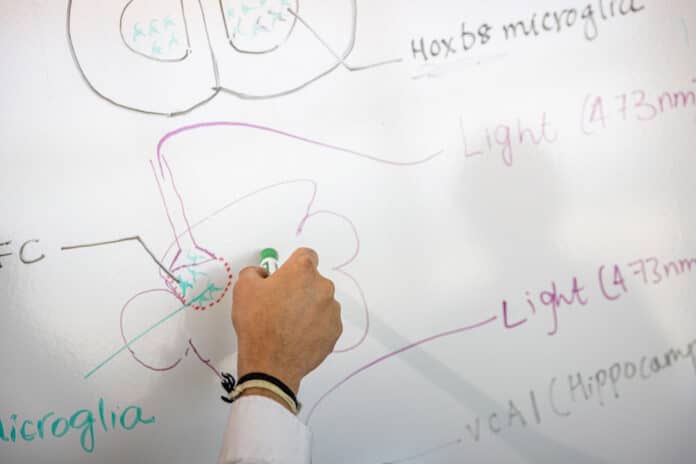Chronic anxiety is an enormous world health problem. Yet our molecular genetic understanding of chronic anxiety and its relation to stress has not dramatically advanced.
Researchers from the University of Utah Health found new information about microglia, a relatively minor type of brain cell, regulating anxiety-related behaviors in laboratory mice. Neurons, the most common type of brain cell, are traditionally believed to control behavior.
Previously, scientists have shown that either disruption of the Hoxb8 gene or ablation of a microglial subpopulation, Hoxb8 microglia, results in mice exhibiting both chronic anxiety and OCSD-like behavior. In this study, scientists found that optogenetic stimulation of Hoxb8 microglia in specific brain regions induces elevated anxiety, grooming, or both.
Optogenetic activation of Hoxb8 microglia in the basolateral amygdala (BLA) or central amygdala (CeA) results in increased anxiety, whereas stimulation of Hoxb8 microglia in the dorsomedial striatum (DMS) or the medial prefrontal cortex (mPFC) causes grooming. Both behaviors and freezing are induced by optogenetic stimulation of Hoxb8 microglia in the ventral CA1 region of the hippocampus (vCA1).
The recently discovered mechanisms might be crucial for keeping behaviors within a healthy range when things are normal. The mechanisms may be responsible for debilitating behaviors in pathological situations.
Accounting for only 10% of cells in the brain, microglia had been thought of as the brain’s “trash collectors” that disposed of dying neurons and abnormally shaped proteins. However, how microglia accomplished these tasks remained a mystery.
To find out the answer, scientists turned to optogenetics. They used lasers to stimulate specific populations of microglia in the brain.
To their surprise, they could turn on anxiety-related behaviors with the flip of a switch. The laser stimulation of Hoxb8 microglia, one subset, increased the mice’s anxiety. The mice groomed themselves when the laser stimulated Hoxb8 microglia in different brain regions. The mice’s anxiety increased, they groomed themselves more, and they froze, a sign of fear when Hoxb8 microglia were targeted in another location. The behaviors ceased each time the scientists switched the laser off.
Naveen Nagajaran, Ph.D., a geneticist and neuroscientist at U of U Health and the study’s lead author, said, “That was a big surprise for us. It is conventionally thought that only neurons can generate behaviors. The findings shed light on how the brain generates behaviors using microglia.”
“In fact, stimulating microglia with the laser caused the neurons sitting next to them to fire more strongly, suggesting that the two cell types communicate to drive distinct behaviors.”
Additional research uncovered a further layer of regulation provided by a group of microglia that do not express Hoxb8. When “non-Hoxb8” and Hoxb8 microglia were stimulated simultaneously, anxiety and OCSD-like behaviors did not start to develop. These findings suggested that the two populations of microglia function as an accelerator and brake, respectively. Under normal circumstances, they counterbalance one another, and when the signals are out of balance, they cause a disease state.
According to the research, two microglial characteristics—location and type—appear crucial for regulating anxiety and OCSD behaviors. Microglia then interact with particular neurons and brain circuits to eventually regulate behavior.
Journal Reference:
- Nagarajan, N., Capecchi, M.R. Optogenetic stimulation of mouse Hoxb8 microglia in specific regions of the brain induces anxiety, grooming, or both. Molecular Psychiatry (2023). DOI: 10.1038/s41380-023-02019-w
